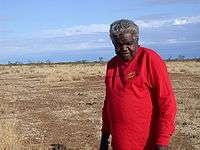Warumungu

The Warumungu (or Warramunga) are a group of Indigenous Australians of the Northern Territory. Modern day Warumungu are mainly concentrated in the region of Tennant Creek and Alice Springs.
History
In the 1870s, early white explorers described the Warumungu as a flourishing nation.[1] However, by 1915, invasion and reprisal had brought them to the brink of starvation.[1][2] In 1934, a reserve that had been set aside for the Warumungu in 1892 was revoked in order to clear the way for gold prospecting. By the 1960s, the Warumungu had been entirely removed from their native land.[1] In 1978, the Central Land Council of the Northern Territory made a claim on behalf of the Warumungu under the Aboriginal Land Rights Act. A lengthy legal battle ensued, in which the litigations eventually went to the High Court of Australia. Fifteen years later, in 1993, most of the land claim was finally returned to the Warumungu.[1] The Warumungu Land Claim is currently made up of ten separate parcels of land, which together make up 3,090 square kilometres (1,190 sq mi).[3] In March 1993, Michael Maurice, a former Aboriginal Land Commissioner, said of the ordeal:
| “ | The problem with the Northern Territory Government then, was it didn't accept the underlying principles of the Aboriginal Land Rights Act. It didn't accept that it was for the Commonwealth to determine the conditions on which Aboriginal people could acquire land in the Northern Territory, so its attitude was one of resistance. | ” |
| — Michael Maurice, March 1993, [1] | ||
Warumungu language
Their language was Warumungu, belonging to the Pama–Nyungan family.[4]). It is similar to the Warlpiri spoken by the Warlpiri people. It is a suffixing language, in which verbs are formed by adding a tense suffix (although some verbs are formed by compounding a preverb).[2] As are many of the surviving Indigenous Australian languages, the Warumungu language is undergoing rapid change. The morphology used by younger speakers differs significantly than the one used by older speakers.[2] An example of a Warumungu sentence might be " apurtu im deya o warraku taun kana ", meaning " Father's mother, is she there, in town, or not? ".[5]
Warumungu is classified as a living language, but the number of speakers seemed to be decreasing quickly and by the mid-1950s, Australian linguist Robert Hoogenraad estimated that there were only about 700 people who could speak some Warumungu;[6] by 1983, the population was estimated to be as small as 200 speakers.[7] Today, the language is in a robust position compared to many indigenous Australian languages, as it is being acquired by children and used in daily interaction by all generations, and the situation is sustainable though some ethnic group members may prefer Kriol.[8][9]
Notes
Citations
- 1 2 3 4 5 The Warumungu.
- 1 2 3 Simpson.
- ↑ Land title grant 1993.
- ↑ Warumungu Language Information.
- ↑ Scholar Sceptic.
- ↑ Aboriginal Child Language Acquisition Project.
- ↑ Warumungu at Ethnologue (15th ed., 2005)
- ↑ Warumungu at Ethnologue (17th ed., 2013)
- ↑ Metcalf & Huntington 1991, p. 49.
Sources
- "Aboriginal Child Language Acquisition Project: Warumungu". Retrieved 22 December 2008.
- Metcalf, Peter; Huntington, Richard (1991). Celebrations of Death: The Anthropology of Mortuary Ritual. Cambridge University Press. p. 49. ISBN 0-521-42375-9.
- "Scholar Sceptic: Australian Aboriginal Studies" (pdf). Retrieved 23 December 2008.
- Simpson, Jane. "Warumungu (Australian: Pama–Nyungan)". Blackwell Reference.
- Tindale, Norman Barnett (1974). "Waramanga (NT)". Aboriginal Tribes of Australia: Their Terrain, Environmental Controls, Distribution, Limits, and Proper Names. Australian National University. ISBN 978-0-708-10741-6.
- "Warumungu land title grant" (Press release). 1 March 1993. Archived from the original on 8 February 2007. Retrieved 23 December 2008.
- "The Warumungu Language". LINGUIST List. Retrieved 24 December 2008.
- "Warumungu Language Information". Global Recordings Network. Retrieved 23 December 2008.
- "The Warumungu: The Land is Always Alive". Central Land Council. Archived from the original on 20 July 2008. Retrieved 23 December 2008.